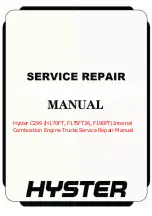
CARRIAGE / LOAD BACKREST /
FORKS
Inspect the carriage, load backrest, and forks for
cracks bends and damage. Never repair forks by
heating them; replace worn or damaged forks.
CONTROL HANDLE
WARNING
If any function does not operate correctly,
repair the fault immediately. DO NOT operate
the lift truck until the problem is corrected.
Put a "DO NOT OPERATE" tag on the control
handle, remove the key, and disconnect the
battery.
Test all operations of the control handle (travel,
lift/lower, tilt, sideshift, aux, horn). Movement of
the handle should be smooth and full.
DECALS
Check to see that none of the operational, safety,
or warning decals are missing or unreadable.
Each of these decals serves a vital function; to
protect the operator, those around the truck, or
the truck itself. Replace any decal that is missing
or unreadable. Refer to the FRAME section of
the PARTS manual for type and placement of
decals on your model lift truck.
GEARBOX
1.
Inspect the gearboxes for fluid leaks and
loose mounting bolts.
2.
Drive the truck forward and reverse in a
straight line. Drive the truck in a tight circle
to the left and right. Operation should be
smooth and free of any unusual noise.
HYDRAULIC SYSTEM
CAUTION
w
The operating temperature of the
hydraulic oil is 90
o
F - 160
o
F.
w
Before disconnecting any hydraulic lines,
relieve the pressure in the lines.
w
Hydraulic oil under pressure can be
injected into the skin. Never check for
leaks by putting hands on a hydraulic line
under pressure.
w
Disconnect the battery while servicing.
w
Never operate the pump without oil in the
hydraulic system. Doing so will damage
the pump.
Check the hydraulic system for leaks and
damaged or loose components. Report damage
immediately. DO NOT operate the lift truck until
problems are corrected. If repair is required, put
a "DO NOT OPERATE" tag on the control handle.
LIGHTS (OPTIONAL)
If your unit is equipped with overhead
guard-mounted work lights, a flashing light, or
stop/tail lights, ensure they function correctly and
are tight.
MAST
WARNING
DO NOT work under a raised carriage. Lower
the carriage and forks to the ground or use a
suitable locking device to prevent the carriage
and inner rails from lowering when
performing maintenance on the mast.
1. Inspect the welds on the rails of the mast for
cracks. Make sure all nuts and bolts are tight,
and that the cotter pins are in place on the tilt
cylinder pins.
2. Check the channels for wear in the areas of
roller contact. Check the rollers for wear or
damage.
3. Check that the chain and hose sheaves
operate smoothly and are not damaged.
4. Raise the carriage slowly without a load.
Check for smooth operation and the correct
sequence when the carriage and rails make
their telescoping movements within the
channels. A wrong sequence when the mast
is raised and lowered indicates that
adjustment is necessary. Refer to the
ELEVATING section.
E
lectric
C
ounterbalance
H
igh
O
utput
Preventive Maintenance
9/1/99
10.5









































